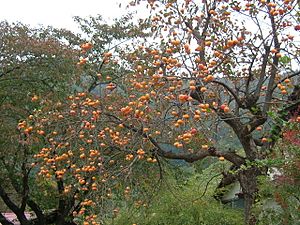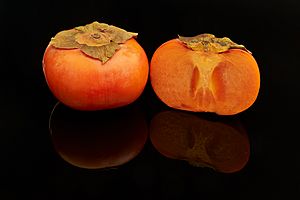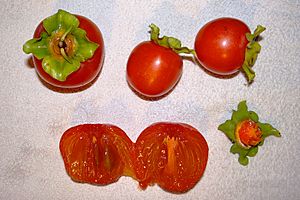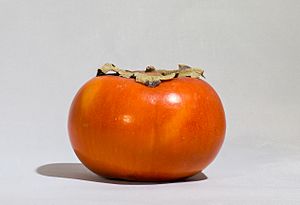Oriental persimmon facts for kids
Quick facts for kids Oriental persimmon |
|
|---|---|
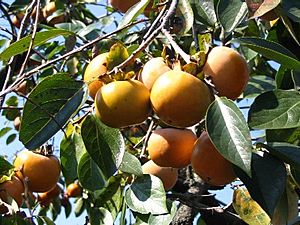 |
|
| Botanical details of buds, flowers and fruit | |
| Conservation status | |
| Scientific classification | |
| Genus: |
Diospyros
|
| Species: |
kaki
|
| Synonyms | |
|
Diospyros chinensis Blume (nom. nud.) Diospyros kaki L.f. |
|
| Oriental persimmon | |||||||||||||||
|---|---|---|---|---|---|---|---|---|---|---|---|---|---|---|---|

The Chinese character for "persimmon"
|
|||||||||||||||
| Chinese name | |||||||||||||||
| Chinese | 柿(子) | ||||||||||||||
|
|||||||||||||||
| Korean name | |||||||||||||||
| Hangul | 감 | ||||||||||||||
|
|||||||||||||||
| Japanese name | |||||||||||||||
| Kanji | 柿 | ||||||||||||||
|
|||||||||||||||
The Oriental persimmon, also known as kaki or Japanese persimmon, is a popular fruit tree. Its scientific name is Diospyros kaki. This tree is the most common type of persimmon grown around the world.
People have been growing and eating persimmons in China for over 2,000 years. It is one of the oldest cultivated plants we know! Even though it has been around for a long time, scientists officially described it in 1780.
Contents
Names of the Persimmon
The scientific name for the persimmon is Diospyros kaki. There was a small disagreement among scientists about who first named it. However, the name given by Carl Peter Thunberg in 1780 is the one officially accepted today.
This fruit has many different names in various languages:
- In Chinese, it is called shi (柿).
- In Japanese, it is called kaki (柿).
- In Korean, it is called gam (감).
- In Indonesia, it is known as kesemek.
- In Nepali, it is called haluwabed (हलुवाबेद).
The Persimmon Tree
A persimmon tree looks a bit like an apple tree. It can grow up to 33 feet (10 meters) tall. Its leaves are medium to dark green and shaped like a wide spear. These leaves fall off the tree each year, just like many other trees.
Persimmon trees usually bloom from May to June. Most trees are either male or female, meaning they only have one type of flower. But some special trees can have both male and female flowers. What's interesting is that the fruits ripen in October and November, often after most of the leaves have already fallen off the tree!
Flowers and Fruit Production
Persimmon trees typically start producing fruit when they are 3 to 6 years old. Their flowers are about 0.8 to 1 inch (2.0 to 2.5 cm) wide. They usually appear in late spring or early summer.
The flowers are creamy white. Female flowers grow by themselves. Male flowers sometimes have a pink tint and often grow in groups of three. Most persimmon trees are either male or female. However, some special types can have both male and female flowers on the same tree.
All persimmon varieties can produce fruit without needing pollination. This means they can make seedless fruit. But if the flowers are pollinated, they will produce more fruit, and these fruits will have seeds.
Persimmon trees often drop a lot of their young fruit. About half of the fruit might fall off shortly after flowering. Then, in August, many more fruits might drop. After these drops, the remaining fruit usually stays on the tree and ripens. Fruit drop can depend on the weather and how much water the tree gets. Pollination is not needed for fruit to grow, but it can help prevent fruit from dropping during bad weather or dry times.
The Persimmon Fruit
The persimmon fruit is sweet and a little tangy. It has a soft, sometimes slightly stringy texture. When ripe, the fruit has a thick, jelly-like inside covered by a thin, waxy skin.
The fruit is round or oval and can weigh up to 1.1 pounds (500 grams). Its smooth, shiny skin can be yellow to red-orange. The inside flesh is usually a bit lighter in color. Some fruits can have up to eight seeds.
Young, unripe persimmons have a bitter taste. This is because they contain a lot of something called tannin. As the fruit ripens, it gets softer, like a kiwi fruit. The bitter taste caused by tannins goes away as the fruit matures. You can also remove the bitter taste by treating the fruit with carbon dioxide gas.
Types of Persimmon Fruits
Persimmon varieties are grouped into four main types. This depends on whether their tannins (the stuff that makes them bitter) are soluble and if they have seeds. Soluble tannin means the fruit will taste bitter. Insoluble tannin means it won't be bitter.
Here are the four types:
- PCA type (Pollination Constant Astringent): These persimmons taste bitter until they become completely soft. As they ripen, the tannins become insoluble, and the bitterness disappears. Then, the fruit is sweet and delicious.
- PCNA type (Pollination Constant Non-Astringent): This type of persimmon is always sweet, even when it's still hard. The tannins are always insoluble, so there's no bitterness at any stage. This type is a newer mutation.
- PVNA type (Pollination Variant Non-Astringent): This fruit needs to be soft before you can eat it, unless it has seeds. A substance in the seeds makes the tannins insoluble. So, if it has seeds, it will be sweet even when hard. Fruit from the same tree without seeds will taste bitter until it softens.
- PVA type (Pollination Variant Astringent): This type is similar to the PVNA type. But here, only the flesh right around the seeds will not be bitter. The rest of the fruit will still taste bitter. This means sometimes only half of the fruit (the part with seeds) might be good to eat, while the other half is bitter if it has no seeds.
For most people and for selling, only the first two types (PCA and PCNA) are important. The other two types are usually treated like PCA fruits because they are often bitter.
What's Inside a Persimmon?
Persimmon leaves contain special compounds called triterpenoids. The fruit itself is very healthy because it has a lot of carotenoids. These include beta-cryptoxanthin, beta-carotene, and zeaxanthin. These are the same things that give carrots their orange color and are good for your eyes!
Growing Persimmon Trees
Persimmons are grown all over the world. About 90% of all persimmons come from China, Japan, and Korea. In East Asia, the main time to harvest persimmons is in October and November. By harvest time, the trees usually lose their leaves. Sometimes, the bright orange fruits are left on the tree as a beautiful decoration.
Growing persimmons first became popular across East Asia. Later, in the 1800s, persimmons started to replace other types of fruit trees in parts of Southern Europe and West Asia. This was because persimmons have bigger fruits. They were also brought to California and Brazil in the 1800s.
The "Sharon" persimmon is a special type grown in Israel. It's a PCA variety, meaning it's usually bitter until treated. Before being sold, it's always treated with carbon dioxide gas to remove the bitterness. This persimmon is somewhat square-shaped and very sweet. It also has a firm skin, which helps it stay fresh longer and makes it easy to handle.
In Spain, the "Rojo Brillante" is a very important persimmon variety. It's mostly grown in the Valencia region. Over the last ten years, a way to treat these persimmons with CO₂ gas has been perfected. This treatment removes the bitterness while keeping the fruit firm. This treated fruit is sold as Spanish Persimon. Because of this, the "Rojo Brillante" persimmon has become very popular around the world.
Italy used to export a lot of persimmons, but now Spain exports more. This is because Italian persimmons are not usually treated with CO₂. So, they can only be eaten after they become soft. Italy is working on CO₂ treatments for its "Tipo" variety, but it's not widely used yet.
Persimmons are also grown in Albania and Bulgaria, though in smaller amounts.
Remember, some persimmon types are bitter when firm because of tannins. These types, like the Japanese 'Hachiya', can only be eaten when they are soft and jelly-like. Other types, like 'Fuyu', don't have tannins when firm. You can eat them like an apple, or let them get soft. However, many people think the non-bitter varieties have a less complex flavor.
Persimmons in the United States
In the United States, most persimmons are grown in Florida and California. The first commercial farms in Florida started in the 1870s. Most persimmon farms in the US are quite small.
Persimmons in Culture
Across Asia, people believe persimmons have healing powers. They are thought to help with stomach problems and diarrhea. Unripe fruits are said to help with fever if they ripen in containers until they are sweet. The juice from unripe fruit is believed to lower blood pressure. The fruit stem is thought to help with coughs.
To make these effects stronger, people peel the fruit. Then they leave it in the sun during the day and in the dew at night. They do this until a white powdery coating forms on the fruit.
In some cultures, a vase with a persimmon cake, a pine branch, and an orange is a symbol. It represents the wish for "great happiness in 100 affairs."
How to Eat Persimmons
The leaves are usually removed before you eat a persimmon. You can peel the skin, but you can also eat it, especially when the fruit is very ripe and the bitter tannins are gone.
Persimmons can also be dried. People often tie two fruits to a string and hang them over a pole to dry.
In Korea, persimmons are often eaten as a dessert or served to guests. The fruit is cut into pieces, and the skin and core are usually removed. Dried persimmons are very popular with children in winter. In autumn, families and farmers collect persimmons and hang them to dry. Sometimes, powdered sugar is added to make them even sweeter.
You can also make persimmon vinegar from Oriental persimmons.
|
See also
 In Spanish: Diospyros kaki para niños
In Spanish: Diospyros kaki para niños



